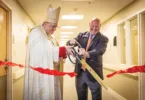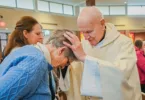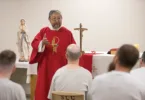by Joe Bollig
joe.bollig@theleaven.org
KANSAS CITY, Kan. — It’s hard for Rose Hammes to pick a favorite story from her Catholic newspaper career, but a top contender has to be the one about the pig.
“One of my favorite things we did every year while I worked in the Diocese of La Crosse [Wisconsin] was on the feast of St. Isidore, on Rural Life Day,” said Hammes. “People would bring their farm animals to be blessed.”
“I remember it rained quite a bit that spring,” she said. “A farmer set up a little pen and put his pig in it. In the course of the hour and fifteen minutes it took for Mass, the pig destroyed the front yard of the church. The look on the pastor’s face when he came out and saw his yard all dug up — things like that I remember. Only in Wisconsin!”
Hammes has come a long way from her reporting days as a Catholic journalist. On Sept. 27, Archbishop Joseph F. Naumann appointed her the new archdiocesan director of communications and planning. She replaced Carroll Macke, who retired in June.
“While many applicants had great experience in business or media, Rose had the comparable experience of actually working for other dioceses,” said Father Gary Pennings, vicar general. “She had demonstrated in other places the ability to do precisely the kinds of things that she would be asked to do here.”
As director, Hammes manages the archdiocese’s official communications. She serves as the public information official for the archdiocese and provides public relations services for parishes. Additionally, she will coordinate regional and diocesan pastoral planning and help parishes implement their pastoral plans.
Hammes was born and raised in Onalaska, Wis., only one house away from the church. Her devout family was involved in many parish activities and she spent most of her school career in Catholic schools.
“The only year of my entire life I didn’t go to Catholic school was kindergarten, and that was because they didn’t offer it,” she said.
Hammes graduated in 1985, with a bachelor’s in business administration and a minor in English, from Viterbo University in La Crosse, Wis. She was hired as an advertising salesperson for the Times-Review (now the Catholic Times of the Diocese of La Crosse) the day after she graduated.
“Slowly but surely, they realized I had some writing skills, so the next thing I knew I was writing for the newspaper,” she said. “I really enjoyed that. I enjoyed going out and meeting the people and writing the stories.”
That all changed when Bishop Raymond Burke became the ordinary of the Diocese of La Crosse in 1994. The diocese didn’t have a communications director at the time, so the bishop asked her to step up to the plate. Soon, she was facing some pretty fast pitches.
“Working for Bishop Burke was an education, because he, like so many of our bishops now, really stood up on issues that for a time the church wasn’t being vocal about,” she said.
“He took the lead in that, which meant we had to deal with a lot of reporters, and a lot of people who call themselves Catholic, even though they don’t agree with church teaching,” she continued. “That’s when I really learned to deal with people and their faith . . . and understanding them.”
In 2004, Hammes was “enticed” to cross the Mississippi River and become communications director in the Diocese of Winona, Minnesota. She worked under Bishop Bernard Harrington and his successor, Bishop John Quinn.
Spending time on both sides of the notebook — as reporter and official spokesperson — taught her a lot about the news and people.
“From both sides of the notebook, my goal has always been to put the Catholic Church in a good light,” she said. “Reporters for the Catholic press are not investigative reporters. They are there to tell the good news. And I don’t think that’s any different when you’re the communications director talking to reporters. You want to tell the good stories.”
And there are plenty of good news stories out there in our parishes. Often, however, they don’t make it into print, onto the airwaves, or out through the new mediums of social communications.
Part of the reason of “what” ends up in the media is because of “why.”
“For probably the past 20 years, the media in general has become so profit- driven that they had to lead with the stories of scandal, because that’s what people wanted to hear. And that’s a sad commentary on our society,” she said.
“But I think in the past four or five years, as the Internet and social media have become more prevalent in people’s lives, people have been looking for support,” she continued. “People are looking for connection to each other, and you don’t find that in the bad news. I’m hoping that, as people use more and more alternate sources of media, the mainstream [will realize] . . . maybe we should do more uplifting stories.”
One way to promote more stories like that is to work on relationships with media outlets. There are people out there in the media who do have an agenda against the Catholic Church, she said, but ignorance is more common. The problem is often that people’s disagreements with the church are based on mistaken assumptions.
And she’s not just referring to the big news outlets like The Kansas City Star or the Topeka Capital-Journal.
“Working with those little weeklies and rural radio stations — that’s the challenge to getting the word out to those folks about things that are going on at the diocesan level,” she said. “No matter where you are, the relationship with the media is pretty much the same. It’s just finding the right connections to talk to the right people.”
And when the news is genuinely bad? The best policy in dealing with it is honesty, she said.
“The days of trying to cover up anything bad that happens in the church are gone,” she said. “I have never agreed with that. I think the church should be transparent to the point that no one’s reputation is being harmed. But if there is bad news, we have to tell it and tell it honestly.”
Another big part of her job will be pastoral planning. This is the continuing challenge parishes face as they are confronted with changes in demographics, the number of priests available for assignments, and resources.
“The regions of the archdiocese have gone through their research, done their studies, and now have to carry out the recommendations they said they would do,” she said.
Hammes is looking forward to all the challenges of her office, but is especially looking forward to doing something she did at the beginning of her career in the Catholic press — getting to know the good news of the good people of the archdiocese.






